By FELICITY DARVILLE
SHE was a little girl, just four years old when she first stepped foot on Bay Street in a colourful, completely fringed outfit to rush in the Junkanoo parade. It was adorable to see little Arlene performing. With eyes beaming and a big, bright smile, she moved to the beat of the Junkanoo drum.
This experience shaped her destiny, lasting through her formative years and beyond. Today, she has given a lifetime of support, provided outlets for education, and has empowered countless Bahamians in this Bahamian cultural legacy. On this, the 50th year of Independence, I see no better time to begin deeming those worthy of their titles – not when they are in their twilight years or when they are dead and gone – but while they are alive. For this reason, I call Arlene Nash-Ferguson the "mother of modern-day Junkanoo".
Arlene considers the start of modern Junkanoo to be the New Year’s Day parade of 1948. Prior to that, there was a six-year hiatus from parading on Bay Street.
For nearly two centuries, Junkanoo has been an integral part of the culture for Bahamians of African descent. In the 1800s, Junkanoo was called a masquerade. Slaves would steal away to secret places to reclaim their heritage. In 1834, slavery was outlawed in The Bahamas, and slaves were fully freed by 1838. The freed Africans continued their practice of celebration – a tradition handed down to them from their families and tribes in west and central Africa.
They would make music by beating on goatskin drums and blowing bugles and horns. Costumes evolved by using newspaper and cloth, which is when the fringing technique was highlighted. During the lucrative sponge era, some costumes were decorated entirely out of sponge.
By the mid-1930s, fringed costumes became bright and colourful with the addition of crepe paper. Groups were formed and prizes were being awarded. But in 1941, a surprise attack on the US naval base in Pearl Harbour would change the course of history. Plunged into the Second World War, the US Army began seeking air bases throughout the neighbouring region to help strengthen its position in the war.
The Bahamas became an anti-submarine and aircraft staging base, and New Providence became an important training ground for aircrews. The sponging industry had collapsed by 1939 and many black Bahamian men found themselves without a job. With US bases being established during the war, “The Project” began, creating 2,000 jobs. Bahamians found out that American workers on The Project were making double their pay. This infuriated the workers and led to the Burma Road Riots on June 1, 1942. Black men marched from their over-the-hill communities into the Public Square in front of government offices. In a furor the men smashed windows of businesses and looted as they went along. The riots continued for two days, racial tension increased, and Nassau was in a state of emergency.
Then Governor of The Bahamas, the Duke of Windsor and former King of England Edward, was abroad when the riots happened. He returned to Nassau, increasing the military, introducing a curfew, and making a public appeal via broadcast.
It was because of this time of unrest that the Junkanoo parade was banned from Bay Street, along with any other kind of parading.
“The drums never stopped beating over the hill,” Arlene told me.
The tradition of Junkanoo parading on Bay Street during Christmas time may have halted, but celebrations continued in earnest in areas like Delancey Town where she was born, and Bain and Grants Town.
Arlene was born to Olga Nash (née Bostfield) and HO Nash in 1950 on Delancey Street, an area affectionately called “the hilltop” at the top of Nassau Street. Her navel string was buried at their home right next to what is now the John Watlings Distillery. Her father was one of the most outstanding teachers in The Bahamas and today, a high school proudly bears his name.
Arelene followed in her father’s footsteps and became a highly regarded educator in her own right, including serving as an illustrious principal at her alma mater, St John’s College, home of the Green Giants. She inspired not only students at that school, but others, like me. Although I attended St Augustine’s College, she invited me to write poems in her school’s bulletin and give speeches at assemblies.
Growing up on the hilltop, Arlene remembers the days when the children were collectively owned by everyone in the community, and any adult had the right to discipline a child. Her father died when she was 19 months old. Her mother promptly moved back to her homestead around the corner on West Street, where Arlene and her brother Garth had the opportunity to grow up with her mother, two aunts and uncle.
These were the days when children played safely in the streets and enjoyed games like hopscotch drawn with a chalky rock. When the kids had the opportunity to go to the Capital Theatre on a Saturday, they would return to their neighbourhood and act out the scenes from movies like Robin Hood and Tarzan.
The kids had their neighbourhood mapped out and would eat their bellies full of cherries, guinep, mangoes and other wonderful fruit. They climbed trees and walked to school, she said, and lived off the land, staying naturally healthy and fit.
The fish man would pass daily, providing the source of the evening’s dinner for the housewives. The ice man would pass too, as many families had yet to own a refrigerator. The streets were alive with sights and sounds, including the horse and carriages going down to Bay Street to appease the tourists, and there were regular processions for churches and funerals.
Richard Dean, also known as “Sweet Richard”, a popular entertainer of the day, would come out on the porch in the afternoons, playing his favourite tunes to entertain the children walking home from school.
It was against this colourful backdrop that Arlene fell in love with Junkanoo. It was customary that people in the community would gather and rush behind the Junkanoo group as they made their way to Bay Street. In her neighbourhood, the group gathered at a local bar called the Punch Bowl, which still exists today.
Arlene’s uncle, Ivern Bostfield, was on the Masquerade Committee and he was instrumental in the agitation for the return of the Junkanoo parade to Bay Street. Ivern was so respected for his efforts that when parading did return, the revelers would rush up West Street to collect him, he would put on his suit, and they would escort him to Bay Street.
Junkanoo returned on New Year’s Day 1948 – a day that Arlene marks as the beginning of modern day Junkanoo. By the time she was four years old in 1954, her family thought it was cute that she was so insistent on being a part of the parade. This was a time when some Bahamian families considered it “improper” to rush on Bay Street – likely due to colonialism and their quest to raise themselves to middle class. It is recorded that women did not join parading in Junkanoo until the 1960s. So Arlene’s “cute” but powerful stance makes her one of the pioneers of women in Junkanoo, even though she was so young at the time.
Olga, her mother, allowed her to join a Junkanoo group led by well-respected businessman Spurgeon Smith. He would collect little Arlene’s suit in early December and return it before Christmas, fully fringed. Her mother would dress her and take her Downtown. When the group reached her point, her mother would hand her over, and under Spurgeon's watchful eyes, Arlene would put on a show. She was able to rush on Boxing Day for years during the time when she attended Western Preparatory School, known as Quarry Mission. She only stopped when she went on to attend St John's College.
After Arlene returned from college, she did what she loved to do. She rushed on Bay Street to the sweet sounds of Junkanoo. She rushed in scrap groups and organised groups, but whatever she did, she gave it her all on Bay.
In the year 2000, her love for education combined with her passion for Junkanoo, resulting in Arlene creating her own dream job. She established the Educulture Junkanoo Museum right at the end of Delancey Street, on West Street, in the heart of the hilltop where her love of country was formed and nurtured.
She shares her love of this amazing display of Bahamian culture in a book that could serve as a textbook for Bahamian children: “Let’s Go to Bay – This is Junkanoo” sold at the Educulture Junkanoo Museum. You can also hear Arlene and other Junkanoo greats on ZNS Radio every Saturday morning.
I met Arlene and her husband Silbert Ferguson at the opening of the Bahamas Museum of Junkanoo on Wednesday, July 5. Arlene, along with Percy “Vola” Francis, who lit up Bay Street yesterday during “the People’s Rush” celebrating the 50th Independence anniversary of The Bahamas, were consultants for the museum.
The Bahamas museum of Junkanoo, located at the Nassau Cruise Port, aims to create a home for the Junkanoo community, where knowledge is collected, stored, and disseminated. It will provide a platform for artisans’ voices and works to be supported and shared through education, exhibitions and research.
Ideas towards Junkanoo changed, and more Bahamians began to participate in Junkanoo after father of the nation Sir Lynden O Pindling, first Bahamian Prime Minister in an independent Bahamas, rushed in Junkanoo parades and declared: “I am Junkanoo!”
“In the future, I would like to see us begin to understand what a powerful educational tool culture is - specifically Junkanoo,” Arlene said.
“I would love to see Junior Junkanoo structured into a deliberate learning experience - not just accidental. I would like to see more opportunities for a wider cross section of Bahamians to get involved. I would like to see culture become an integral part of the curriculum so children understand ‘who dey is’. In Junkanoo, the lines are becoming blurred with such strong foreign influence in our country. We want our children to have a very strong sense of who we are as Bahamians.”
“I make a distinction between Junkanoo and the Junkanoo parades. For the parades – we must take steps to preserve their cultural integrity. We have adopted features of carnival in costuming. The music is not in danger, but costuming … the nakedness on Bay Street goes against what Junkanoo has always been. We need to talk and debate on what we want to keep - what makes us different from the rest of the world, and take steps to preserve it.
For this reason, she supports the opening of the Bahamas Museum of Junkanoo and hopes to see more establishments to preserve this beloved Bahamian culture in New Providence and the Family Islands.
Like a loving mother watching the growth of the culture, Arlene recited a Junkanoo poem entitled “The Drums Never Stop” written by the Bahamas Museum of Junkanoo. It was performed with the reigning king of the Junkanoo drum, Reuben “Rupapumpum” Deleveaux.
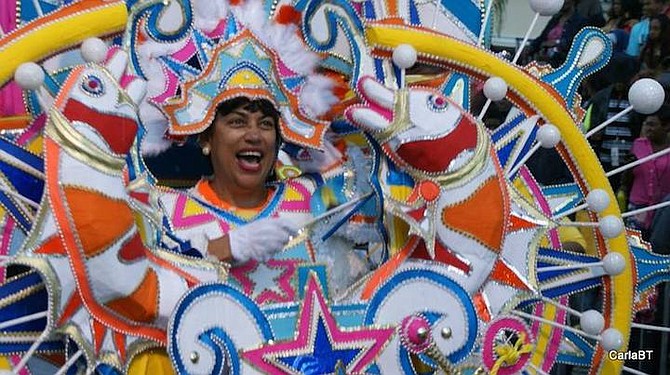
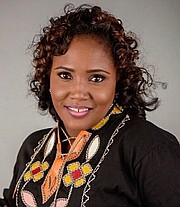
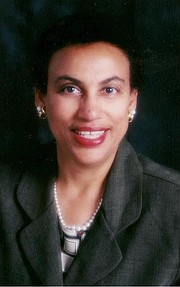
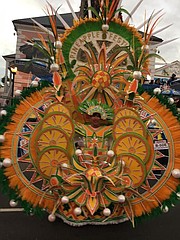
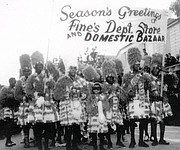
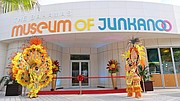
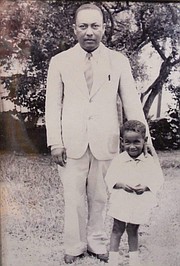




Comments
Use the comment form below to begin a discussion about this content.
Sign in to comment
Or login with:
OpenID